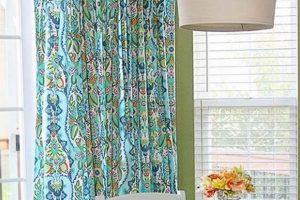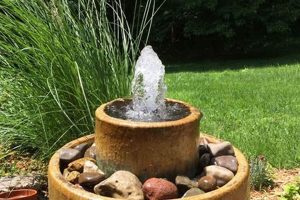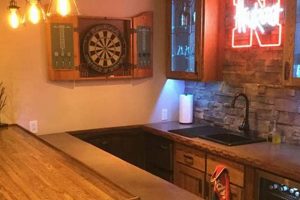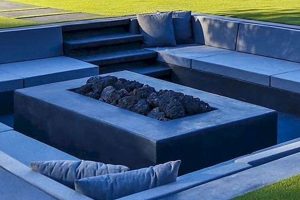The creation of decorative containers for floral arrangements through individual effort represents a popular activity. These projects involve transforming ordinary materials into unique receptacles for showcasing botanical displays. For example, glass bottles can be painted and embellished, or tin cans can be covered with fabric and trim to serve as stylish plant holders.
Engaging in these crafting pursuits provides opportunities for personalized home decor, cost savings, and environmentally conscious repurposing of discarded items. Historically, handcrafted containers have reflected local cultures and artistic trends, evolving from simple utilitarian objects to elaborate expressions of individual creativity. This trend also promotes sustainability through reuse and recycling.
The following sections will detail various techniques and material options available for developing these personalized botanical displays. This exploration will cover methods from simple repurposing to more involved construction, offering inspiration and guidance for creating customized decor.
Tips for Creating Decorative Plant Holders
Effective development of homemade decorative containers requires careful consideration of material selection, design aesthetics, and functional integrity. The following tips offer guidance in achieving successful and visually appealing results.
Tip 1: Material Selection is Key. Opt for durable and water-resistant materials. Glass, ceramic, and treated metals offer longevity and protection against moisture damage. Consider the aesthetic properties of each material to complement the intended floral arrangement.
Tip 2: Surface Preparation is Crucial. Prior to applying any decorative finishes, ensure surfaces are clean, dry, and properly primed. This step enhances adhesion and prolongs the life of the decorative treatment. For example, sanding metal surfaces and applying a rust-inhibiting primer is recommended before painting.
Tip 3: Consider Scale and Proportion. The size and shape of the container should complement the size and shape of the floral arrangement it will house. A top-heavy arrangement in a small, lightweight container is prone to tipping. A properly proportioned container enhances the overall aesthetic appeal.
Tip 4: Incorporate Drainage Solutions. For live plants, adequate drainage is essential to prevent root rot. Incorporate drainage holes in the base of the container or utilize a separate inner pot with drainage capabilities. Consider adding a layer of gravel or pebbles at the bottom to improve drainage.
Tip 5: Explore Decorative Techniques. Various decorative techniques, such as painting, decoupage, mosaic, and wrapping, can be employed to personalize the container. Experiment with different textures, colors, and patterns to achieve a unique design. For example, applying textured paint or adhering small tiles creates visual interest.
Tip 6: Sealing for Protection. Apply a sealant or varnish to protect the decorative finish from water damage and wear. This step is particularly important for containers intended for outdoor use. Select a sealant appropriate for the chosen materials and decorative techniques.
Tip 7: Consider Structural Integrity. When repurposing items, ensure the structure is sound and stable. Reinforce weak points with adhesives or structural supports. A wobbly or unstable container poses a risk of damage to the arrangement and surrounding environment.
Successful creation of custom floral containers relies on a combination of practical construction techniques and artistic expression. Paying attention to material selection, surface preparation, and structural integrity enhances both the functionality and aesthetic appeal of the finished product.
These tips will provide a foundation for embarking on projects outlined in the subsequent sections of this resource.
1. Material Selection
Material selection constitutes a foundational element in the successful execution of personalized floral container projects. The properties inherent in chosen materials directly influence the durability, aesthetic quality, and functionality of the finished receptacle. Careful consideration of these properties is essential for ensuring the longevity and appropriateness of the crafted item.
- Durability and Longevity
The selected material must withstand environmental factors, including moisture and temperature fluctuations. Glass, ceramic, and treated metals offer superior resistance to degradation, ensuring extended use. In contrast, porous materials like untreated wood or cardboard require protective coatings to prevent water damage and premature deterioration.
- Aesthetic Compatibility
Material selection dictates the visual style of the container. Glass offers transparency and a modern aesthetic, while terracotta imparts a rustic charm. The texture and color of the material should complement the intended floral arrangement. Mismatched aesthetics detract from the overall presentation.
- Structural Integrity
The material must possess adequate strength to support the weight of the flowers, water, and container itself. Thin glass may be unsuitable for large, heavy arrangements, while reinforced concrete offers robust support. Structural failure compromises the integrity of the design and poses a potential safety hazard.
- Environmental Impact
Material selection influences the environmental footprint of the project. Repurposing discarded items, such as glass bottles or tin cans, promotes sustainability by reducing waste. Utilizing materials derived from renewable resources minimizes environmental impact compared to relying on non-renewable resources.
The correlation between material selection and project success extends beyond mere aesthetics. Each material characteristic directly impacts the functional lifespan and overall environmental effect. Therefore, a thorough evaluation of material properties is critical for optimizing both the artistic expression and practical utility of the floral display.
2. Design aesthetic
The design aesthetic chosen in the context of individually crafted floral containers significantly influences the overall visual impact and perceived value of the botanical arrangement. The selection of a particular aesthetic, encompassing elements such as color palette, form, and texture, dictates how the created item interacts with its surroundings and complements the flora it contains. A disconnect between the container’s design and the intended aesthetic diminishes the arrangement’s visual harmony. For instance, a sleek, minimalist container may enhance the elegance of orchids, whereas a rustic, textured vessel might better suit wildflowers. This symbiotic relationship between container and contents necessitates a deliberate
approach to design selection.
Several factors contribute to the practical application of design aesthetics in this pursuit. Material choice, construction technique, and decorative embellishments must align with the chosen aesthetic. A container intended to evoke a sense of vintage charm might incorporate distressed paint finishes and repurposed materials, while a contemporary design could utilize clean lines, geometric shapes, and reflective surfaces. Consideration must also be given to the environment in which the container will be displayed; a design suitable for a modern urban loft may not be appropriate for a traditional country home. Successfully integrating these elements translates into a visually cohesive and aesthetically pleasing final product.
In summation, the design aesthetic represents a critical determinant in the efficacy of homemade floral containers. Challenges arise when the selected design clashes with the intended purpose or surroundings. Awareness of design principles, coupled with careful material selection and construction, allows for the creation of visually harmonious and functionally appropriate pieces. This understanding contributes to the overall success of the individual crafting endeavor and enhances the aesthetic appeal of the associated floral arrangement.
3. Structural Integrity
Structural integrity, in the context of individually crafted floral containers, represents the ability of the receptacle to maintain its shape and functionality under anticipated conditions of use. This characteristic is paramount, directly influencing both the longevity of the item and the safety of its environment. A failure in structural integrity can result in collapse, spillage, and potential damage to surrounding objects.
- Material Strength and Load Capacity
The inherent strength of the selected material dictates the maximum weight the container can support without deformation or fracture. Glass, for instance, possesses high compressive strength but is susceptible to tensile stress, requiring careful handling and design considerations. The load capacity must account for the weight of the container itself, the contained water, and the mass of the floral arrangement.
- Joint and Connection Stability
When a container is constructed from multiple components, the integrity of the joints and connections becomes critical. Adhesives, fasteners, and welding techniques must create bonds that withstand sustained pressure and environmental exposure. Weak or improperly executed joints are prone to failure, particularly under conditions of fluctuating temperature or humidity.
- Base Support and Stability
The design of the base directly influences the stability of the container. A wide, stable base provides a low center of gravity, reducing the risk of tipping. An uneven or poorly designed base can create instability, potentially leading to accidental spills or damage to the arrangement.
- Resistance to Environmental Degradation
Exposure to moisture, sunlight, and temperature variations can compromise the structural integrity of certain materials. Untreated wood, for example, is susceptible to rot and decay, while some plastics can become brittle under prolonged exposure to ultraviolet radiation. Selecting materials that resist environmental degradation or applying protective coatings enhances the lifespan of the container.
The principles of structural integrity, therefore, are not merely theoretical considerations but practical imperatives in the design and construction of custom floral containers. Adhering to sound engineering principles and selecting appropriate materials ensures that the finished product is not only aesthetically pleasing but also safe and durable, capable of fulfilling its intended purpose for an extended period.
4. Water Resistance
Water resistance is a critical factor in the design and construction of homemade floral containers. The ability of a receptacle to withstand prolonged exposure to moisture directly impacts its longevity, structural integrity, and functionality. Inadequate water resistance leads to material degradation, potential leaks, and ultimately, failure of the container.
- Material Permeability
Different materials exhibit varying degrees of permeability to water. Porous materials, such as untreated wood and certain types of unglazed ceramics, readily absorb water, leading to swelling, warping, and eventual decay. Non-porous materials, such as glass, metal, and certain plastics, offer inherent resistance to water penetration. Material selection should prioritize impermeability or necessitate the application of protective coatings to mitigate water absorption.
- Seam and Joint Sealing
Containers constructed from multiple components require effective sealing of seams and joints to prevent water leakage. Adhesives, sealants, and welding techniques must create impermeable barriers that withstand hydrostatic pressure. Inadequate sealing results in gradual water seepage, leading to damage to surrounding surfaces and potential structural weakening of the container.
- Protective Coatings and Finishes
The application of water-resistant coatings and finishes provides an additional layer of protection against moisture damage. Paints, varnishes, and sealants create a barrier that prevents water from penetrating the underlying material. The selection of appropriate coatings is crucial, as some finishes may degrade or delaminate upon prolonged exposure to water. Regular maintenance and reapplication of coatings may be necessary to maintain water resistance.
- Drainage Considerations
While water resistance focuses on preventing leakage, proper drainage is also important for containers housing live plants. Waterlogged soil can lead to root rot and plant death. Incorporating drainage holes or a layer of gravel at the base of the container allows excess water to escape, promoting healthy plant growth while simultaneously mitigating potential damage to the container itself.
Therefore, a comprehensive approach to water resistance involves careful material selection, effective sealing techniques, the application of protective coatings, and consideration of drainage requirements. Neglecting any of these facets compromises the overall performance and lifespan of the floral container, undermining the aesthetic value and practical utility of the crafting endeavor.
5. Plant compatibility
Plant compatibility, within the framework of customized floral containers, is the degree to which a plant’s biological needs align with the physical characteristics of the receptacle. This relationship directly impacts the plant’s health, longevity, and aesthetic presentation. Mismatched compatibility may result in stunted growth, disease, or premature demise, thereby negating the aesthetic intention.
- Root System Accommodation
The dimensions of the container must adequately accommodate the plant’s root system. Constricted root growth inhibits nutrient uptake
and water absorption, leading to stress and potential mortality. For example, shallow-rooted succulents thrive in wide, low containers, while deep-rooted species require taller, narrower vessels. Failure to provide sufficient space compromises the plant’s capacity to develop a healthy root structure. - Moisture Retention and Drainage
Different plant species exhibit varying requirements for soil moisture. Succulents and cacti demand well-draining soil to prevent root rot, necessitating containers with ample drainage holes. Conversely, moisture-loving plants benefit from containers that retain water, albeit without becoming waterlogged. Selecting a container with appropriate drainage characteristics is crucial for maintaining optimal soil moisture levels.
- Material Toxicity
Certain materials employed in container construction may leach harmful chemicals into the soil, posing a threat to plant health. Treated wood, for example, may contain preservatives that are toxic to plant roots. Selecting inert materials or lining the container with a non-toxic barrier prevents the leaching of harmful substances, ensuring a safe growing environment.
- Light Exposure and Reflectivity
The container’s color and surface texture can influence light exposure to the plant. Dark-colored containers absorb heat, potentially stressing roots, while reflective surfaces can concentrate sunlight, leading to leaf burn. Considering these factors allows for the creation of containers that promote optimal light conditions for the specific plant species.
The integration of plant compatibility principles into container design represents a critical element in achieving successful botanical displays. Ignoring these considerations compromises plant health and undermines the overall aesthetic objective. A well-designed container not only complements the plant’s visual characteristics but also provides a supportive and nurturing environment.
6. Cost effectiveness
The pursuit of personally crafted floral containers is often driven by the desire for cost savings. Commercial floral receptacles can be expensive, particularly those with unique designs or constructed from premium materials. The creation of similar items through individual effort offers a potential avenue for significant expenditure reduction. This advantage stems from the ability to utilize readily available, often discarded, materials and to circumvent retail markups. For example, transforming glass bottles into decorative containers requires minimal investment beyond the cost of paint or embellishments, representing a substantial saving compared to purchasing comparable items from a store.
The impact of cost effectiveness extends beyond mere financial considerations. Engaging in crafting activities often promotes resourcefulness and creativity, encouraging individuals to find innovative uses for otherwise discarded items. This, in turn, fosters a sense of environmental responsibility by reducing waste and promoting recycling. The economic benefits are realized not only through direct cost savings but also through the reduced consumption of commercially produced goods. Moreover, the crafting process allows for complete customization, ensuring that the finished product perfectly aligns with individual aesthetic preferences, a level of personalization rarely achievable with mass-produced items.
In summation, cost effectiveness serves as a primary motivator and a significant benefit within the realm of custom-made floral containers. The ability to repurpose materials, avoid retail pricing structures, and promote resourcefulness collectively contributes to the economic appeal of this activity. While aesthetic considerations and personal expression play a role, the underlying financial advantages remain a central component, ensuring that the creation of individual floral displays remains an accessible and economically viable pursuit.
7. Decorative technique
Decorative technique, as applied to individually crafted floral containers, represents the specific methodologies employed to augment the aesthetic appeal of the receptacle. These techniques encompass a diverse range of artistic processes, each capable of transforming a plain, functional object into a visually engaging element of interior decor. The judicious selection and execution of these techniques directly influence the overall aesthetic impact of the final product.
- Painting and Surface Treatment
Painting involves the application of pigmented coatings to alter the color, texture, and visual characteristics of the container’s surface. Techniques range from simple brushstrokes to intricate patterns and specialized finishes, such as crackle or metallic effects. Surface treatments, including varnishing and sealing, protect the painted surface and enhance its durability. For example, applying a weather-resistant sealant to a painted terracotta pot allows for outdoor use. The use of stencils and masking tape may allow to create different patterns.
- Decoupage and Image Transfer
Decoupage involves adhering paper cutouts or printed images to the container’s surface, creating a collage-like effect. Image transfer techniques, such as using transfer paper or specialized solutions, allow for the direct application of images onto the receptacle. These methods provide opportunities for incorporating personalized imagery, patterns, and textures into the design. Properly sealed decoupage paper is water resistant.
- Mosaic and Tile Work
Mosaic involves adhering small pieces of glass, ceramic, or stone tiles to the container’s surface, creating intricate patterns and designs. Tile work employs larger tiles to achieve a more structured and geometric aesthetic. These techniques add texture, visual complexity, and a sense of handcrafted artistry to the floral display. The grout between the tiles needs to be waterproof.
- Wrapping and Embellishment
Wrapping techniques involve encircling the container with various materials, such as fabric, twine, rope, or ribbon, to alter its visual appearance. Embellishments, including beads, buttons, shells, and other decorative elements, can be affixed to the surface to add texture, color, and visual interest. These methods offer opportunities for incorporating tactile elements and personalizing the design with unique materials.
The effective utilization of decorative techniques in crafting personalized floral containers necessitates a careful consideration of material compatibility, design coherence, and functional requirements. Each technique offers unique possibilities for aesthetic expression, transforming commonplace objects into artistic components of botanical displays. The judicious application of these methods elevates the perceived value of homemade creations, bridging the gap between utilitarian objects and artistic expressions.
Frequently Asked Questions
This section addresses common inquiries regarding the creation of customized floral containers. The following questions and answers provide guidance on various aspects of this craft.
Question 1: What are the primary benefits of creating custom floral containers?
The construction of customized floral containers offers several advantages, including cost savings, pers
onalized design options, and environmentally conscious repurposing of materials.
Question 2: What materials are suitable for crafting durable floral containers?
Durable materials include glass, ceramic, and treated metals. These materials offer resistance to moisture and physical damage, ensuring longevity.
Question 3: How can water resistance be ensured in homemade floral containers?
Water resistance can be achieved through the use of impermeable materials, effective sealing of seams and joints, and the application of water-resistant coatings.
Question 4: What design considerations are important for creating aesthetically pleasing floral containers?
Key design considerations include color palette, form, texture, and compatibility with the intended floral arrangement and surrounding environment.
Question 5: How does plant compatibility influence the design of floral containers?
The dimensions of the container must accommodate the plant’s root system, and the material should not leach harmful chemicals into the soil. Proper drainage is also essential for preventing root rot.
Question 6: What decorative techniques can be employed to enhance the aesthetic appeal of floral containers?
A variety of decorative techniques can be utilized, including painting, decoupage, mosaic, and wrapping. The selection of techniques depends on the desired aesthetic and material compatibility.
The creation of personalized floral containers involves a combination of practical construction techniques and artistic expression. Addressing the aspects detailed above enhances both the functionality and aesthetic appeal of the finished product.
The subsequent sections will detail specific techniques and materials available for creating these personalized botanical displays. This exploration will cover methods from simple repurposing to more involved construction, offering inspiration and guidance for creating customized decor.
Conclusion
This exploration of DIY vase ideas has underscored the multifaceted nature of creating personalized floral containers. Considerations ranging from material selection and structural integrity to plant compatibility and decorative technique directly influence the outcome of these projects. Adherence to sound construction principles and thoughtful design choices enables the creation of aesthetically pleasing and functionally sound receptacles.
The successful implementation of DIY vase ideas transforms ordinary materials into unique expressions of individual creativity. As environmental consciousness grows, these projects offer a sustainable and economically viable alternative to commercially produced items, fostering resourcefulness and promoting personalized home decor. Further exploration and innovation in this area hold the potential to refine existing techniques and discover novel approaches to botanical presentation.







